By Ljubica Nedelkoska, Tim O’Brien and Daniel Stock
Download PDF | Listed to the podcast interview
SUMMARY OF FINDINGS
Sri Lanka has exceptionally low rates of tertiary education admission and graduation for its level of economic development. Many have identified this as a roadblock to Sri Lanka’s economic competitiveness. Using six years of Sri Lanka’s Labor Force Survey, we study the evidence of shortages of tertiary educated workers. Our analysis casts doubt on the existence of a general shortage of university graduates in spite of the low university admission and graduation rates. We find that the majority (77%) of university graduates are employed by the public sector (government and semi-government), where they enjoy job security and other benefits but earn wages that are only a fraction of what is paid in the private sector. On average, college graduates in the private sector earn 1.6 times higher wages than college graduates in the public sector. Moreover, the wages of college graduates in the public sector are only between a quarter and a third higher than those of A-level graduates in the same sector. A minority (23%) of college graduates are employed by the private sector, where they earn significantly more than those with only A-levels – 66% in the case of men and 128% more in the case of women. These very high wage premiums in the private sector, combined with very low unemployment rates of college graduates, suggest shortages of particular types of tertiary education. This seems to be the case with ICT professionals and ICT technicians, business professionals, science and engineering professionals, and various managerial occupations. This suggests that education policy should focus on addressing the shortages in these areas, as opposed to expanding tertiary education more generally. A general expansion of higher education without a focus on these fields could actually further lower the already low returns to a tertiary degree in the public sector, without addressing any issues of Sri Lanka’s economic competitiveness.
BACKGROUND
Sri Lanka’s gross enrollment ratio (GER) in tertiary education reached close to 20% in 2015, placing it among the lowest rates of all middle-income countries. The average GER among middle-income countries is 33%, and all countries in the region, including India and Indonesia, have significantly higher tertiary education enrollment rates than Sri Lanka. This has led many to believe that Sri Lanka has too few individuals with tertiary education. In its flagship publication "Sri Lanka: State of the Economy 2017," researchers at the Institute of Policy Studies in Sri Lanka identified skill gaps in the educational system as one of the key roadblocks towards higher competitiveness of the Sri Lankan economy. The report reads: "As of 2014, only 5 percent of 20-24-year olds were enrolled in a university, while another 8 percent were enrolled in other educational institutions and only 3 percent of the same age group were enrolled in technical education and vocational training (TVET) courses." It goes on to explain that the main reasons for these low enrollment rates are capacity constraints of the state university system together with the low level of development of private sector education and the TVET system. In the same vein, the Government of Sri Lanka agrees that "education and skills development are currently inadequate to sustain growth through knowledge-based, competitive economic activities" and plans to increase access to secondary and tertiary education (Vision 2025).
While education serves various important roles such as intellectual enrichment, social mobility and social status, the primary purpose of education from an economic perspective is to make us more productive on the labor market. Most economists believe that the positive returns to education (i.e., the wage premium associated with an extra year of education keeping other factors constant) observed worldwide suggest that education helps companies become more productive and, in return, these companies are willing to pay higher wages for better-educated employees.
If too few university graduates is a key constraint to higher competitiveness of the economy of Sri Lanka, we would expect to see companies in the private sector fiercely competing for those few new graduates that emerge each year from Sri Lanka’s higher education institutions. As a result of this competition, we would expect the unemployment rates of university graduates to be low, and the wage premium they are paid to be high. These two characteristics would together give a clear signal that Sri Lanka is facing shortages of tertiary education graduates.
ARE SRI LANKAN UNIVERSITY GRADUATES EASILY FINDING JOBS?
The average annual rate of net university graduates inflows into the labor market between 2011 and 2015 based on Labor Force Survey (LFS) data was around 23,000. On the aggregate, there were about as many net new jobs created for these graduates over the same time period, suggesting a very high job placement rate. As a result, the employment rates for highly educated men remained very high (about 94%), while those of highly educated women even increased, from 73% in 2010 to 84% in 2015 (Figure 1). These aggregate patterns indeed suggest that the labor market of university graduates is tight.
Figure 1: Unemployment and non-participation rates of university graduates and postgraduates by gender
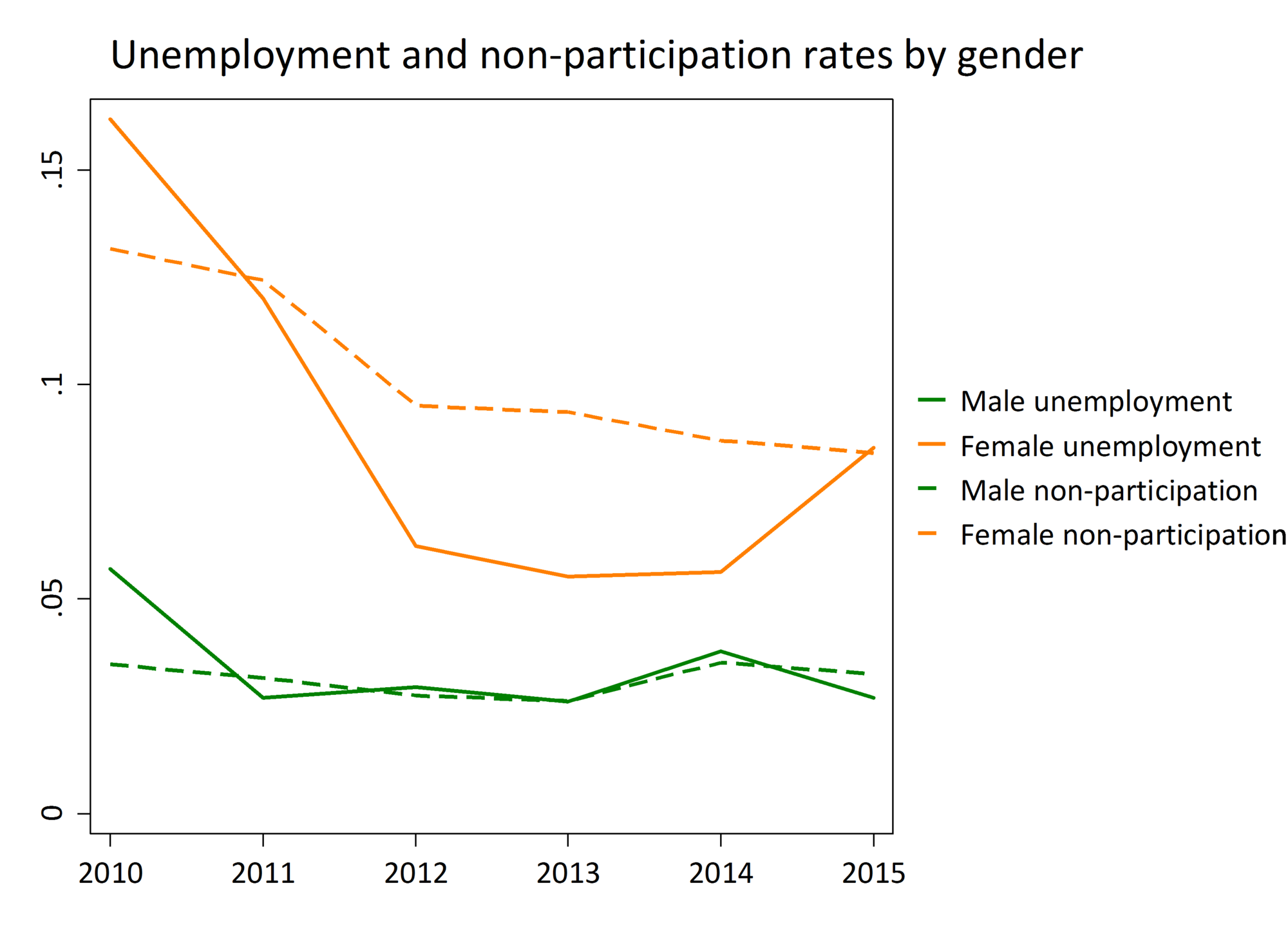
Source: Labor Force Survey (LFS) Sri Lanka 2010-2015. Note: Includes 15-65 year olds, all higher education levels and institutions.
DO UNIVERSITY GRADUATES RECEIVE HIGH WAGE PREMIUMS AT THE JOB?
As a reference, a college graduate in OECD countries, where the supply of tertiary educated is significantly higher than in Sri Lanka, earns about 57% more than a counterpart with no more than a high school education. The United States has earnings premium on the high end at 77%. In Sri Lanka, across all sectors, the premium to tertiary education over A-levels was 51% in 2015 (Figure 2), which is decent, but below the OECD average. Given the low supply and high rate of employment of university graduates, one would expect to see higher wage premiums. This leaves us somewhat puzzled: why should a country with drastically lower supply of university graduates than OECD countries have lower than average returns to tertiary education? Such pattern could indicate that the education obtained through the university system is not particularly valuable to the employers. The average premium could also disguise important differences in the returns to a tertiary degree among different groups of graduates. We think that the group distinction that will help us best explain the above patterns is the one between university graduates who opt to work in the public sector and those who opt to work in the private sector.
Figure 2: Premium of a college degree over A-levels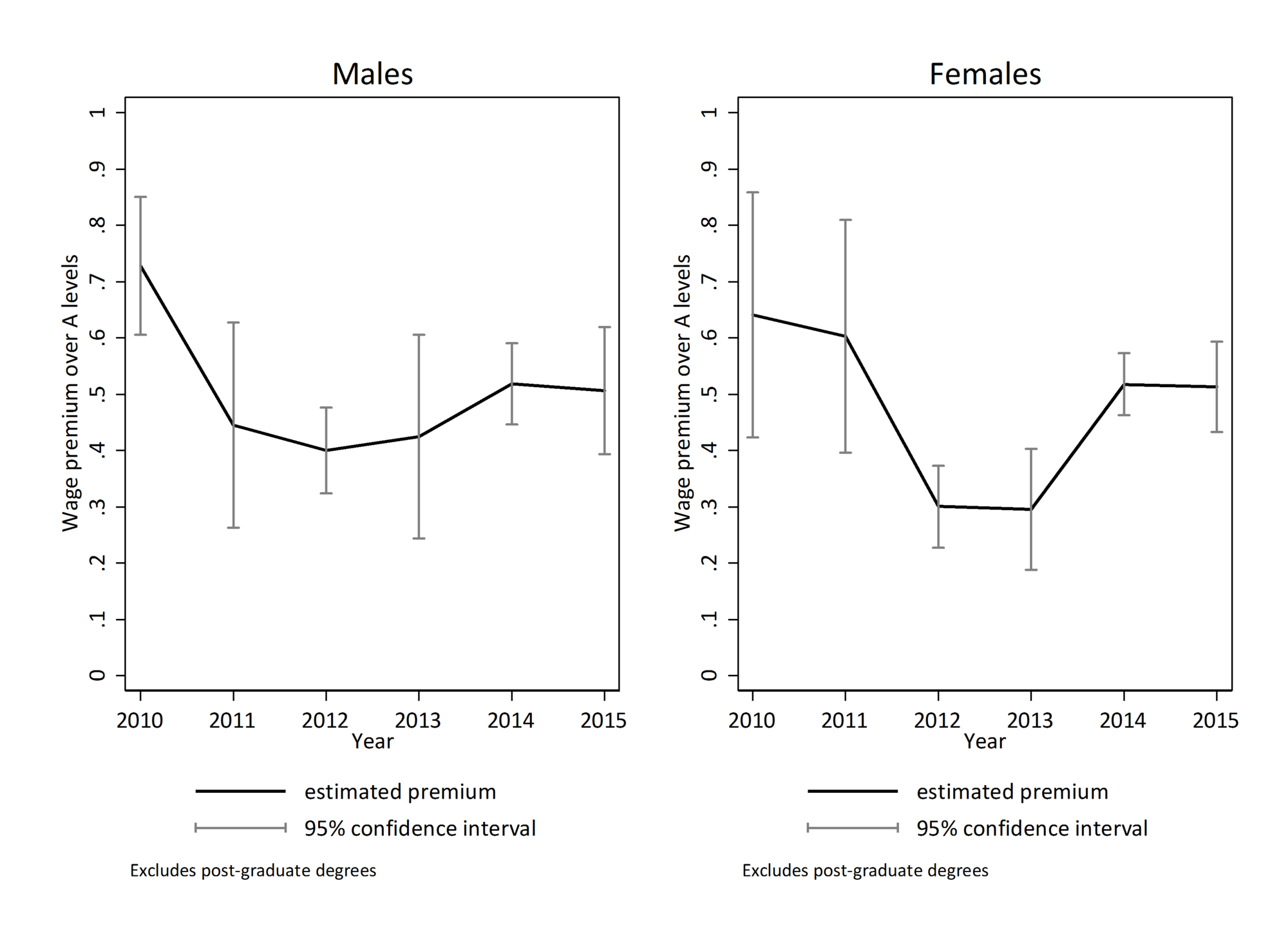
Source: Labor Force Survey (LFS) Sri Lanka 2010-2015
Note: Includes 15-65 year olds. To keep the group of college graduates homogenous, the premium is estimated for those with Bachelor’s degrees only, i.e., we exclude those with post-graduate degrees. Each estimate is the coefficient of a dummy variable indicating whether a person completed a Bachelor’s degree from a Mincer regression that controls for potential work experience and labor market entry cohort effects. Separate regressions were run for each year and gender combination. The reference educational category is those with completed A levels. The dependent variable is the log of the real hourly wage.
In 2015, the private sector only employed 23% of all university graduates, while the government and the semi-government sector employed the other 77%. This casts a doubt on the claim that the private sector is hungry for university graduates in general. The patterns of premiums to a college degree by sector introduce another layer of complexity to the story. The premium is low in the public sector, where college-educated men earned a 36% premium over A-levels and college-educated women earned a 25% premium over A-levels in 2015. Whereas in the private sector, college-educated men earned a 66% premium over A-levels and college-educated women earned a whopping 128% premium (Figure 3). A further comparison of the university graduates in the public versus the private sector shows that a male university graduate, on average, earned 1.5 times more per month in the private sector than in the public sector, while a female university graduate, on average, earned 1.7 times more.
Figure 3: Premiums to tertiary education by sector and gender
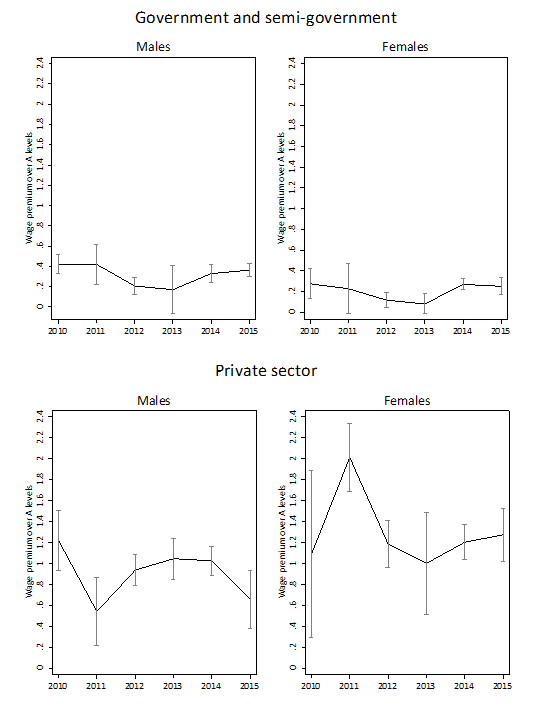
Source: Labor Force Survey (LFS) Sri Lanka 2010-2015.
Note: Includes 15-65 year olds. To keep the group of college graduates homogenous, the premium is estimated for those with Bachelor’s degrees only, i.e., we exclude those with post-graduate degrees. Each estimate is the coefficient of a dummy variable indicating whether a person completed college education from a Mincer regression that controls for potential work experience and labor market entry cohort effects. Separate regressions were run for each year, sector and gender combination. The reference educational category is those with completed A levels. The dependent variable is the log of the real hourly wage.
WHY IS THE PRIVATE SECTOR EMPLYING FEW UNIVERSITY GRADUATES BUT PAYING SIGNIFICANT PREMIUMS, WHILE THE PUBLIC SECTOR IS EMPLOYING MANY BUT PAYING LOW PREMIUMS?
Why don’t more university graduates go to the private sector where wages are high, and capture some of these earnings differences? There can be different reasons for this, but here we will focus on one very important reason. The types of university graduates that the private sector needs are quite specific. They are different from those employed by the public sector and different from the majority of graduates produced by the university system. The most common professions for university graduates in the private sector are: managers and production managers (25%), science and engineering professionals (14%), business administration associate professionals (10%), teaching professionals (9%), business and administration professionals (6%), ICT professionals (5%) and science and engineering technicians (5%). The most common professions for university graduates in the public sector are: teaching professionals (45%), business administration associate professionals (18%), clerks (8%), and health professionals (8%) (Figure 4).
Figure 4: Occupational composition of university graduates by sector
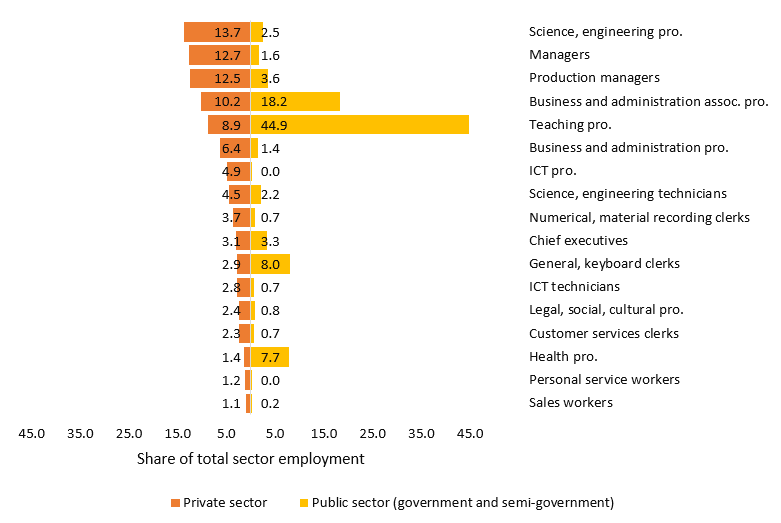
Source: Labor Force Survey (LFS) Sri Lanka 2010-2015.
Note: Includes 15-65 year olds. The estimated shares are averages over 6 years. Sorted by share of employees in the private sector. Includes the 17 (out of 38) largest occupations in the private sector. All excluded occupations contribute less than 1% of employment in both the private and the public sector.
WHICH PROFESSIONS ARE MOST LIKELY IN SHORT SUPPLY?
We compare the hourly wages of university graduates in various occupations, regardless of whether public or private sector, to the hourly wages of the teaching professionals (the largest group among university graduates). We control for the level of labor market experience, gender, cohort effects, and for whether one has a post-graduate degree, to ensure that we compare the wages of individuals that are otherwise similar. ICT professionals earn 106% more than teaching professionals; production managers and chief executives earn 33-35% more; engineers earn 25% more; and health professionals and ICT technicians earn 24% more than teaching professionals (Figure 5). Having a post-graduate degree is associated with additional 20% premium. As anticipated, most of the professions with higher returns than the teaching profession are typically employed in the private sector. By paying wages significantly higher than the ones of the typical employee with tertiary education, the private sector is signaling that they need these specific professions and that they may have hard time finding such candidates in the Sri Lankan labor market. In other words, these are the professions/educational fields where an expansion of the tertiary education could most likely help relax a skill shortage constraint. Outside these professions, we find little evidence of educational shortages at the tertiary level.
Figure 5: Occupational premiums among university graduates
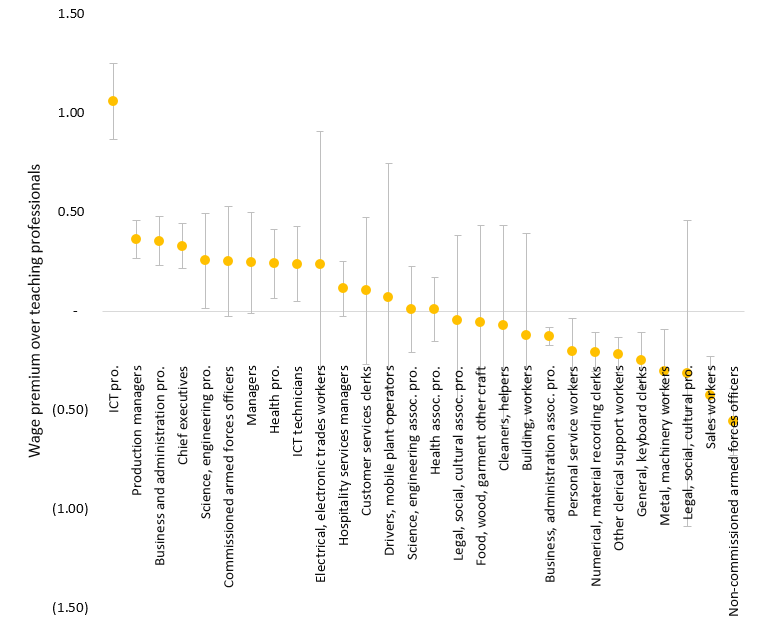
Source: Labor Force Survey (LFS) Sri Lanka 2010-2015.
Note: Includes 15-65 year olds, all sectors, tertiary graduates only. Results from a Mincer-like equation, but with occupational dummies instead of education. Controls include potential labor market experience and its square term, labor market cohort dummies, a gender dummy and a dummy for having a post-graduate degree. The whiskers correspond to the 95% confidence intervals. The dependent variable is the log of the real hourly wage.
CONCLUSIONS AND POLICY DISCUSSION
Using data from the Labor Force Survey of Sri Lanka (2010-2015), we study the claim that skill gaps resulting from the restrictive tertiary education system of Sri Lanka present a serious challenge to the economic competitiveness of Sri Lanka. Theoretically, skill gaps can restrain companies’ choice of employees, both in terms of numbers and quality. There are two straightforward tests that we perform in order to see whether such skill gaps exist. First, we check if college graduates have an easy time finding jobs in Sri Lanka, and second, we measure the returns to their college degrees. We expect that employment rates are high and returns to education are high for degrees that are in short supply. We find that this is the case only with a subset of occupations/educational fields at the university level: ICT professionals and technicians, managers and executives, business and administration professionals, science and engineering professionals, and health professionals. The majority of these are employed in the private sector where, the returns to a college degree are high. However, the private sector only employs 23% of all university graduates, while the public sector (government and semi-government) employ the other 77%. The public sector pays 40% less than the private sector wages paid to university graduates on average. Unless the public sector vastly compensates for this wage differential with more generous fringe benefits and higher job security, we have to conclude that we only find evidence for skill gaps in a fraction of Sri Lanka’s college majors listed above.
The Vision 2025 of the Government of Sri Lanka (GoSL) envisages an expansion of the tertiary education system. Our findings inform that, when doing so, GoSL should focus on the expansion of particular college majors, and not on the general expansion of the higher education system. Increasing the access to ICT, managerial, engineering, business and healthcare professions in particular would benefit the Sri Lankan economy as it will expand the companies’ choice of workers and enable them to grow faster that they can do now.
A question to explore further is whether the scope of this expansion should go beyond the system of higher education, and include the system of vocational training and secondary education. Previous research (Dundar et al. 2017) has shown that the capacity of science and engineering education at the tertiary level is restricted by the low capacity of the secondary education to equip the students with the basics of science, meaning that the expansion of tertiary education in these fields will need to be accompanied by expansion of science education at the secondary level. Moreover, Sri Lanka has a well-developed system of vocational training and it is worthwhile exploring whether the TVET could partially help bridge some of these gaps with strong participation of the private sector that is facing the skill shortages.
Finally, like most developing economies, Sri Lanka faces significant brain drain. Sri Lanka is a net exporter of many professions including engineers and engineering technicians (CID 2018). Although Sri Lanka pays high wages for engineers relative to other professions in the country, Sri Lanka does not pay internationally competitive wages for their professionals. The salary of a mid-level engineer in Colombo for instance was among the lowest in Asia and Oceania in 2012 (JETRO 2013) – about half of what a mid-level engineer is paid in Beijing and only 16% of what the equivalent engineer is paid in Singapore. However, Sri Lanka does not have a choice but to further expand the supply of shortage professions. Only a supply push can help the existing industry expand and potentially attract further capital investments, including foreign investments in Sri Lanka.
| sri lanka university graduates 2018.pdf | 332 KB |
